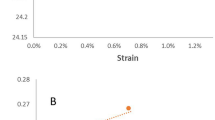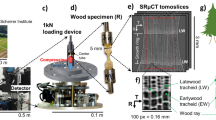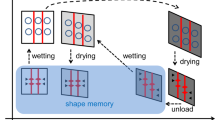Abstract
The remarkable mechanical properties of biological materials reside in their complex hierarchical architecture and in specific molecular mechanistic phenomena1,2,3. The fundamental importance of molecular interactions and bond recovery has been suggested by studies on deformation and fracture of bone and nacre4,5,6. Like these mineral-based materials, wood also represents a complex nanocomposite with excellent mechanical performance, despite the fact that it is mainly based on polymers. In wood, however, the mechanistic contribution of processes in the cell wall is not fully understood7,8,9. Here we have combined tensile tests on individual wood cells and on wood foils with simultaneous synchrotron X-ray diffraction analysis in order to separate deformation mechanisms inside the cell wall from those mediated by cell–cell interactions. We show that tensile deformation beyond the yield point does not deteriorate the stiffness of either individual cells or foils. This indicates that there is a dominant recovery mechanism that re-forms the amorphous matrix between the cellulose microfibrils within the cell wall, maintaining its mechanical properties. This stick–slip mechanism, rather like Velcro operating at the nanometre level, provides a 'plastic response' similar to that effected by moving dislocations in metals. We suggest that the molecular recovery mechanism in the cell matrix is a universal phenomenon dominating the tensile deformation of different wood tissue types.
This is a preview of subscription content, access via your institution
Access options
Subscribe to this journal
Receive 12 print issues and online access
$259.00 per year
only $21.58 per issue
Buy this article
- Purchase on Springer Link
- Instant access to full article PDF
Prices may be subject to local taxes which are calculated during checkout





Similar content being viewed by others
References
Weiner, S. & Wagner, H.D. The material bone: structure-mechanical functions relations. Annu. Rev. Mater. Sci. 28, 271–298 (1998).
Ashby, M.F., Gibson, L.J., Wegst, U. & Olive, R. The mechanical properties of natural materials. I. Material property charts. Proc. R. Soc. Lond. A 450, 123–140 (1995).
Gordon, J.E. & Jeronimidis, G. Composites with high work of fracture. Phil. Trans. R. Soc. Lond. 294, 545–550 (1980).
Smith, L.B. et al. Molecular mechanistic origin of the toughness of natural adhesives, fibres and composites. Nature 399, 761–763 (1999).
Thompson, J.B. et al. Bone indentation recovery time correlates with bond reforming time. Nature 414, 773–776 (2001).
Nalla, R.K., Kinney, J.H. & Ritchie, R.O. Mechanistic fracture criteria for the failure of human cortical bone. Nature Mater. 2, 164–168 (2003).
Niklas, K.J. Plant Biomechanics (Univ.Chicago Press, Chicago, 1992).
Meylan, B.A. & Butterfield, B.G. Helical orientation of the microfibrils in tracheids, fibres and vessels. Wood Sci. Technol. 12, 219–222 (1978).
Cave, I.D. The anisotropic elasticity of the plant cell wall. Wood Sci. Technol. 2, 268–278 (1968).
Jentzen, C.A. The effect of stress applied during drying on some of the properties of individual pulp fibers. TAPPI J. 47, 412–418 (1964).
Navi, P., Rastogi, P.K., Gresse, V. & Tolou, A. Micromechanics of wood subjected to axial tension. Wood Sci. Technol. 29, 411–419 (1995).
Spatz, H.-CH., Köhler, L. & Niklas, K.J. Mechanical behaviour of plant tissues: Composite materials or structures? J. Exp. Biol. 202, 3269–3272 (1999).
Köhler, L. & Spatz, H.-C. Micromechanics of plant tissues beyond the linear-elastic range. Planta 215, 33–40 (2002).
Lichtenegger, H., Reiterer, A., Stanzl-Tschegg, S.E. & Fratzl, P. in Microfibril Angle in Wood (ed. Butterfield, B.G.) 140–156 (IAWA, Leiden, The Netherlands, 1998).
Schniewind, A.P. & Barrett, J.D. Cell wall model with complete shear restrain. Wood Fiber 1, 205–214 (1969).
Burgert, I., Keckes, J., Frühmann, K., Fratzl, P. & Tschegg, S.E. A comparison of two techniques for wood fibre isolation—evaluation by tensile tests on single fibres with different microfibril angle. Plant Biol. 4, 9–12 (2002).
Hepworth, D.G. & Vincent, J.F.V. Modelling the mechanical properties of xylem tissue from tobacco plants (Nicotiana tabacum 'Samsun') by considering the importance of molecular and micromechanisms. Ann. Bot. 81, 761–770 (1998).
Yamamoto, H. & Kojima, Y. Properties of cell wall constituents in relation to longitudinal elasticity of wood. Part 1. Formation of the longitudinal elasticity of an isolated wood fiber. Wood Sci. Technol. 36, 55–74 (2002).
Burgert, I., Frühmann, K., Keckes, J., Fratzl, P. & Stanzl-Tschegg, S.E. Microtensile testing of wood fibers combined with video extensometry for efficient strain detection. Holzforschung (in the press).
Fengel, D. & Wegener, G. Wood—Chemistry, Ultrastructure, Reactions (De Gruyter, Berlin, 1998).
Bergander, A. & Salmen, L. Cell wall properties and their effects on the mechanical properties of fibers. J. Mater. Sci. 37, 151–156 (2002).
Acknowledgements
We thank H. Lichtenegger for discussions at early stages of this project. This work was supported by the Fonds zur Förderung der wissenschaftlichen Forschung (FWF-P14331).
Author information
Authors and Affiliations
Ethics declarations
Competing interests
The authors declare no competing financial interests.
Supplementary information
Rights and permissions
About this article
Cite this article
Keckes, J., Burgert, I., Frühmann, K. et al. Cell-wall recovery after irreversible deformation of wood. Nature Mater 2, 810–813 (2003). https://doi.org/10.1038/nmat1019
Received:
Accepted:
Published:
Issue Date:
DOI: https://doi.org/10.1038/nmat1019
This article is cited by
-
Bioinspired nanocomposites with self-adaptive mechanical properties
Nano Research (2024)
-
Investigation of native cellulose under high pressure using microfocused synchrotron radiation
Cellulose (2023)
-
Interpreting SAXS data recorded on cellulose rich pulps
Cellulose (2022)
-
Nanostructural deformation of high-stiffness spruce wood under tension
Scientific Reports (2021)
-
Effects of moisture and cellulose fibril angle on the tensile properties of native single Norway spruce wood fibres
Wood Science and Technology (2021)



